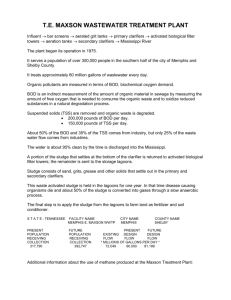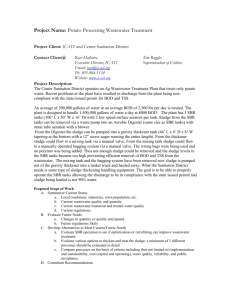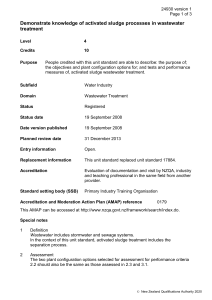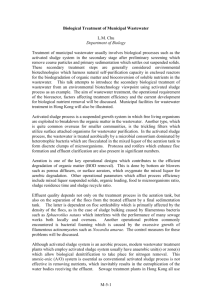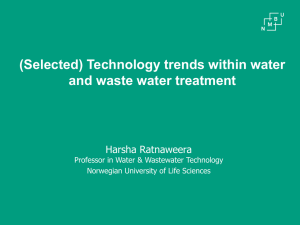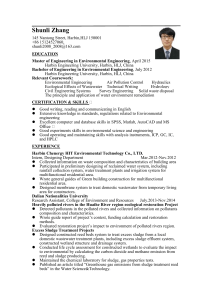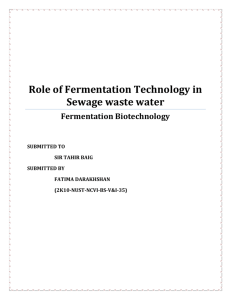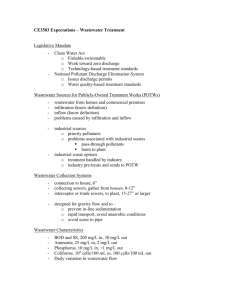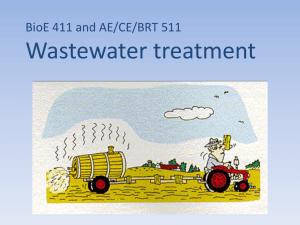Fundamentals of Wastewater Treatment
advertisement
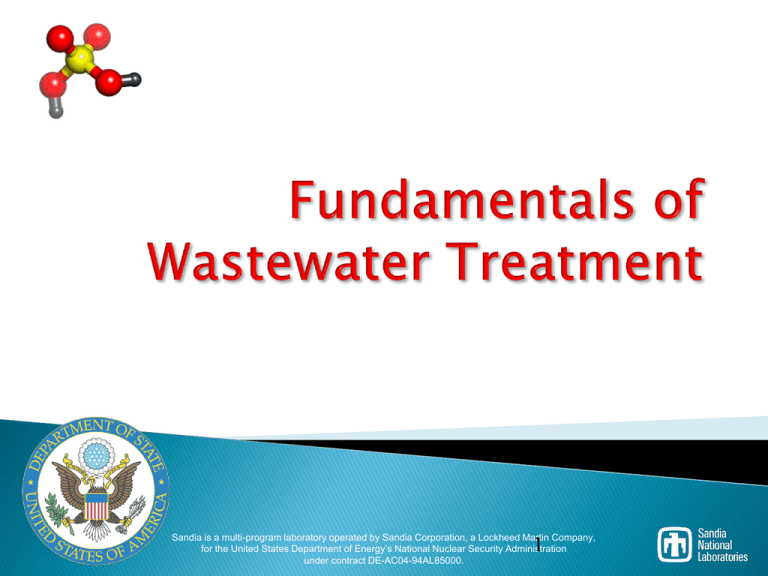
1 Sandia is a multi-program laboratory operated by Sandia Corporation, a Lockheed Martin Company, for the United States Department of Energy’s National Nuclear Security Administration under contract DE-AC04-94AL85000. Activated sludge processes ◦ Fixed film and suspended processes Aerobic/anoxic/anaerobic processes modifications. Nutrient removal ◦ nitrification / denitrification, phosphorous removal Water reuse and reclamation ◦ membrane bioreactors Disinfection Satellite and On-site Wastewater Treatment 2 Bacteriological, ◦ Vibrio Cholerae, Campylobacter, Salmonella , Shigella, Viruses ◦ Hepatitis A, Norovirus Protozoan ◦ Giardia, Cryptosporidium, Entamoeba Biological oxygen demand ◦ Organic matter causes algae to thrive and deplete dissolved oxygen Nutrient removal to prevent eutrophication ◦ Nitrogen and phosphorus from waste, and agriculture 3 What does wastewater look like? Measurement Value Units Total Suspended Solids (TSS) 210 mg/L BOD 190 mg/L TOC 430 mg/L COD 140 mg/L Organic Nitrogen 15 mg/L Free Ammonia 25 mg/L Nitrite/Nitrate 0/0 mg/L Phosphorous 7 mg/L Total coliform 107-109 colonies/100mL Fecal coliform 104-106 colonies/100mL Cryptospiridium oocysts 0.1-10 no./100mL Giardia Lamblia 0.1-100 no./100mL Source: Wastewater Engineering, Metcalf and Eddy- medium strength WW 4 • Testing for pathogens directly is expensive and hazardous • Indicators from the family Enterobacteriacae are used (E. Coli, Citrobacter,Enterobacter, Klebsiella) • Grow bacteria on a specified medai and count the number of colonies after incubation • Other assays are used and are approved by the US EPA (Colilert shown) 5 Fixed film process Screens Primary settling Suspended growth process Grit remova l Digeste r Sludge drying6 Fixed film biological processes Biofilm Aerobic Facultative/Anaerobic Bed Media ~1 mm 100µm Waste Water 7 Treated Water Fixed film biological processes Trickling filter Uses biofilm to treat water to remove BOD 8 Trickling filter effectiveness BOD5 removal rates for trickling filters Filter Type Hydraulic loading m3/m2day BOD5 Removal (%) Low Rate 1-4 80 - 90 Intermediate 4-10 50 - 70 High Rate 10-40 65 - 85 Roughing Filter 40 - 65 Source: Environmental Engineers Handbook, 1997. 9 Suspended growth biological processes Waste Water Activated Sludge Anoxic Aerobic Coagulation Clarifier sludge Treated Water Return activated sludge Anoxic – no dissolved oxygen 10 BOD and nutrient (nitrogen and phosphorous) removal Aerobic Conditions Anaerobic/Aerob ic Conditions BOD + O2 CO2 + increased cell mass P Aerobic Conditions Organic N Anoxic Conditions NO3 NH4 Alum inorgani c sludge increased cell mass organic sludge N2 NO2 NO3 11 Suspended growth activated sludge processes requires energy • Use forced air suspension of biological sludge to reduce BOD • Largest expense for this process is the electrical energy required 12 Activated sludge process stages Anoxic Basin Aerobic Basin Sedimentation Final Clarification 13 Anaerobic sludge digestion reduces solids - makes methane Anaerobic sludge digestors produce methane (65% CH4 - 35% CO2) On-site electricity is produced with the methane 50% of plant power (2.2MW) 14 Sedimentation C6H14 Biomass + CO2 Norg NH3+ Mixin g Aeration NO2 N2 Solids Handling Sedimentation 15 NH3+ NO2 Exemplary process stages Modified LudzackEttinger (MLE Process) A2 O Bardenpho RAS = Return Activated Sludge WAS = Waste Activated Sludge 16 Diesel Generators C6H14 + H2O Anaerobic Fermentation (30 days) CH4 + CO2 6.6 MW Biosolids Centrifuges Disposal or Reuse (150 t/day) Aeration Blowers 17 CO2 H2S N2 HOCl- SO2 Sewers H2O+C+N+S O2 Power Settling & Aeration Microbes (Biosolids) River H2O Heat CO2 Fermentation Composting CO2 Humus CH4 18 NH3+ Water reuse often uses membrane bioreactor with submerged membranes Conventional activated sludge plant MBR membrane cassette • Uses submerged hollow fiber membranes • High Solids Retention Time membrane bioreactor 19 Membrane bioreactors offer small size, high rate of reaction for satellite WW Screens Anoxic Aerobic Submerged Membrane 20 Membrane separation spectrum Source: Zenon Membranes 21 Screen before membrane bio reactor 22 Kubota MBR pilot plant 23 Raw feed and MBR product 24 Reverse osmosis after MBR makes water suitable for groundwater recharge RO treated water is better than most surface water sources 25 Hyperion Wastewater Plant Los Angeles 450 mgd 10% of discharge from this plant is sent to microfiltration plant to purify for groundwater injection 26 West Basin Microfiltration Plant (35 mgd from Hyperion) Submerged microfiltration for treated wastewater effluent 27 The final step is disinfection and discharge (no residual free chlorine) • Chlorination to kill the remaining pathogens • Cl2 HOCl • Dechlorination to remove chlorine • SO2 + HOCl + H2O HCl + H2SO4 • SO2 + NH2Cl + 2H2O NH4Cl + H2SO4 • UV radiation reduces chemical needs and chlorinated products 28 Effect of wastewater on disinfection Chlorine Ozone UV BOD,COD,TOC Chlorine demand Ozone demand Little effect Oil and grease Chlorine demand Ozone demand May block light Nitrite Forms NDMA Oxidized No effect Nitrate Forms chloramines Reduce O3 effectiveness No effect Oxidized Oxidized May block light Yes Yes, but nonchlorinated No Iron and Manganese Forms disinfection byproducts Source: Wastewater Engineering- Metcalf & Eddy 29 Satellite and on-site waste disposal Satellite facilities are mid scale sewage treatment plants that treat waste near the point of generation • Lagoons • Aeration ditches • Trickling filters • Membrane bioreactor On-site waste disposal is septic tank system with drain field • Provides low cost alternative • Can be very effective • Need little maintenance (but maintenance is important) 30


